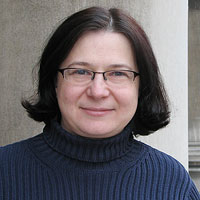
Catalina Achim
Associate Director of Nanotechnology, CNAST; Professor of Chemistry
Research
In the Achim Lab, our research philosophy is that the rational organization of transition metal ions that have unpaired electrons can lead to nano-scale systems with magnetic and electronic properties particularly amenable for nanotechnology, molecular electronics and biotechnology applications. This idea is supported by the sophisticated way in which nature uses transition metal ions and clusters incorporated in proteins to accomplish physical and chemical functions essential for sustaining life.
Our method for the organization of transition metal ions in nano-structures is biomimetic. We have adopted nucleic acids as scaffold in which substitution of nucleobases with ligands with high affinity for transition metal ions makes possible the incorporation of the metal ions at predefined positions. The combination of interactions specific for nucleic acids and for coordination complexes leads to novel structures that for example can be used as platforms for the investigation of spin and magnetic interactions on electron transfer.
Our research is enabled by use of organic synthesis of modified peptide nucleic acid monomers, solid phase peptide synthesis of peptide nucleic acids, UV Vis, CD, NMR and EPR spectroscopy, as well as isothermal calorimetry. We also benefit from collaborations within Carnegie Mellon University (Prof. Danith Ly, Mike Hendrich and Roberto Gil) and outside Carnegie Mellon University (Prof. David Waldeck at University of Pittsburgh, Prof. David Beratan at Duke University, and Prof. Rudy Schlaf at University of South Florida).
Publications
De Leon, A.R.; Olatunde, A.; Morrow, J.; Achim, C. Binding of Eu3+ to HOPO-Modified Peptide Nucleic Acids. Inorg. Chem. 2012, DOI: 10.1021/ic301790v.
Wierzbinski, E.; De Leon, A.; Davis, K.L.; Bezer, S.; Wolak, M.A.; R. Achim, C.; Waldeck, D.H. Influence of Incorporation of Zinc(II) to Bipyridine-Modified Peptide Nucleic Acids on their Charge Transfer Properties. Langmuir 2012, 28, 1971–1981.
Wierzbinski, E.; De Leon, A.; Yin, X.; Balaeff, A.; Davis, K. L.; Rappiredy, S.; Keinan, S.; Venkatramani, R.; Beratan, D.N.; Ly, D.H.; Achim, C.; Waldeck, D.H. Influence of the Backbone on Charge Transfer in Peptide Nucleic Acid Duplexes. J. Am. Chem. Soc. 2012, 134, 9335–9342.
Bezer, S. Rappiredy, S.; Skorik, Y.A.; Ly, D.H.; Achim, C. Coordination-Driven Inversion of Handedness in Ligand-Modified PNA. Inorg. Chem. 2011, 50, 11929-11937.
Ma, Z.; Olecknowicz, F.; Skorik, Y.A.; Achim, C. Metal Binding to Ligand-Containing PNA. Inorg. Chem. 2011, 50, 6083–6092.
Venkatramani, R. Davis, K.L.; Wierzbinski, E.; Bezer, S.; Balaeff, A.; Keinan, S., Paul, A., Kocsis, L., Beratan, D.N., Achim, C., Waldeck, D.H. Evidence for a Near-Resonant Charge Transfer Mechanism for Double-Stranded Peptide Nucleic Acid. J. Am. Chem. Soc. 2011, 133, 62-72.
Wolak, M.A.; Balaeff, A. Gutmann; S. Helmrich, H.J.; Vosloo, R.; Beerbom, M.M.; Wierzbinski, E.; Waldeck, D.H.; Bezer, S.; Achim, C.; Beratan, D. N.; Schlaf, R. Electronic Structure of Self-Assembled Peptide Nucleic Acid Thin Films. J. Phys. Chem. C. 2011, 115, 17123–17135.
He, W.; Crawford, M.J.; Madrid, M.; Gil, R.R.; Ly, D.H.; Achim, C. The Structure of a γ-Modified Peptide Nucleic Acid Duplex. Molecular Biosystems 2010, 6, 1619–1629.
Paul, A.; Watson, R. M.; Wierzbinski, E.; Davis, K.L.; Sha, A.; Achim, C.; Waldeck, D.H. Distance Dependence of the Charge Transfer Rate for Peptide Nucleic Acid Monolayers. J. Phys. Chem. B. 2010, 114, 14140–14148.
Yeh, J.I.; Pohl, E.; Truan, D.; He, W.; Sheldrick, G.M.; Du, S.; Achim, C. The Crystal Structure of Non-Modified and Bipyridine-Modified PNA Duplexes. Chemistry - A Eur. J. 2010, 16, 11867–11875.